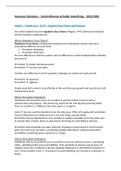Summary
Summary Literature + Knowledge clips - SIPA Social Influence, Public Communication and Advertising - 2022/2023
- Course
- Institution
English summary of the 7 articles and 8 knowledge clips of SIPA Social Influence, Public Communication and Advertising.
[Show more]



